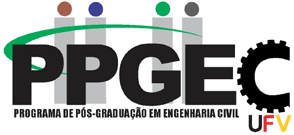Strategic Planning
Development Process and Timeline
In 2020, the Graduate Program in Civil Engineering (PPGEC) at UFV began implementing a systematic strategic planning process, structured in four-year cycles. The Strategic Planning Policy was developed with broad participation from the academic community, including faculty members, students, staff, and alumni. It provides for annual evaluations conducted by a representative committee from the Program. The revised policy for the 2025–2028 cycle was finalized in the first semester of 2024, with strengthened biennial self-assessment and the use of quantitative indicators for continuous monitoring.
Integration with Institutional Planning
The PPGEC’s planning is aligned with UFV’s Institutional Development Plan (PDI 2024–2029), particularly in the areas of Research, Graduate Studies, Internationalization, and Innovation. Additionally, the Program contributes to institutional goals related to education, outreach, culture, and sustainability. This alignment ensures institutional coherence and enhances the impact of planned actions.
Methodology and Tools Used
The planning process was based on a SWOT analysis, CAPES evaluations, and internal self-assessment reports. From these inputs, strategic and operational objectives were defined along with performance indicators and annual targets. All actions were organized into a detailed action plan that identifies responsibilities, timelines, justifications, methods, and estimated costs. The adopted model emphasizes decentralized and participatory management and integrates SEI and Sucupira systems as support tools.
Objectives and Actions by Strategic Axis
Education and Curriculum Development
The curriculum was restructured, with the creation and removal of courses, inclusion of English-language offerings, and systematic evaluation by both faculty and students. The goal is to foster interdisciplinary learning and align the curriculum with current demands.
Knowledge Production
PPGEC aims to increase publications in high-impact journals, enhance technical and technological outputs, and boost the number of theses and dissertations linked to scientific publications. Awards and training sessions are planned to support these outcomes.
Internationalization
Targets include increasing student and faculty participation in exchange programs, joint supervision, and international partnerships, along with greater involvement of foreign members in examination committees. International promotion of the Program and offering of courses in foreign languages have been strengthened.
Innovation and Technology Transfer
Actions are planned to foster entrepreneurship and innovation, including support for startups, patent filings, and expansion of technical outputs with practical applications. Strengthening ties with CENTEV and developing specific courses are part of this strategy.
Infrastructure and Funding
The plan calls for resource mobilization through public and private partnerships and funding calls, aimed at supporting research, scholarships, and infrastructure improvements. The expansion of laboratories such as PMS and use of resources from agencies like FINEP and DNIT are concrete examples.
Program Consolidation
The strategy seeks to increase the Program’s appeal, reduce dropout rates, shorten graduation times, and improve integration among its research areas. Actions include student support, improvement of the selection process, and encouragement of participation in internal academic events.
Development Management and Monitoring
Faculty performance is reviewed annually based on intellectual output and compliance with program regulations. Students are monitored every semester in terms of academic performance and adherence to deadlines. The established indicators are evaluated by area of concentration to identify specific needs and prioritize actions.
Faculty Renewal
The faculty renewal policy yielded significant results in the last four-year period, with the addition of five Young Permanent Faculty Members (JDPs), strengthening key research areas. This process is guided by criteria on academic productivity and program engagement and will be improved in the 2025 revision of the Program’s regulations.
Summary of Expectations and Monitoring
The goals for the 2025–2028 strategic plan are organized by strategic axis and specified through annual indicators. Monitoring will be systematic, with regular updates to Sucupira and process documentation in SEI. The proposed actions aim to ensure sustainable growth, quality training, social and scientific impact, and increased national and international visibility for the Program.
